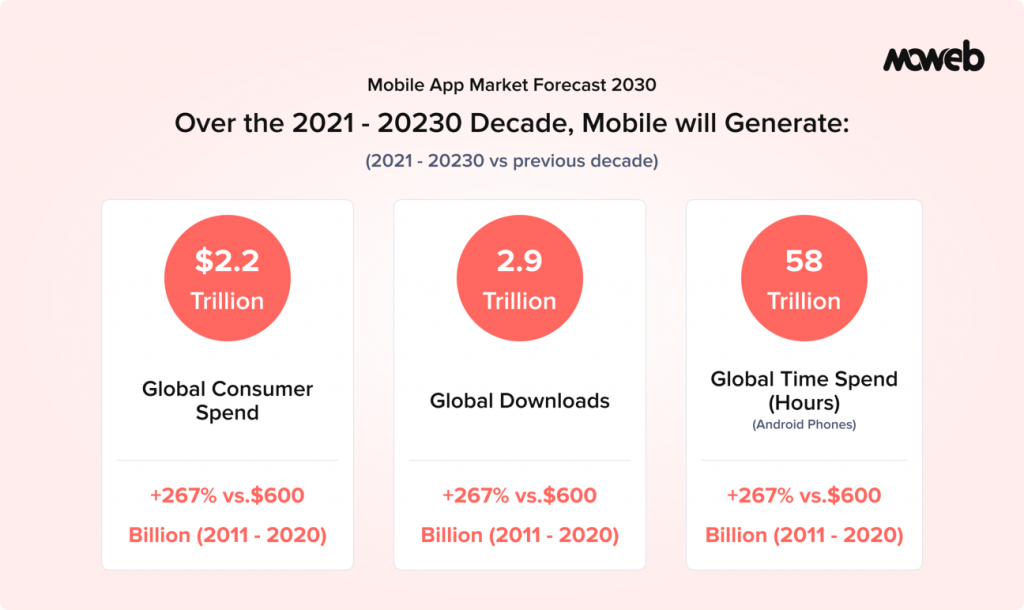
Quick Overview
As we move into 2025, the mobile app development landscape is poised for significant transformation. From integrating cutting-edge technologies like AI/ML to leveraging IoT and enhancing user experiences through cross-platform solutions, mobile apps are becoming more intelligent, connected, and versatile. This blog will explore the latest mobile app development trends, including the growing importance of Generative AI services, hybrid app development, IoT integration, and the push towards cross-platform development. We’ll delve into statistics, and key trends shaping the future and offer insights into how businesses can stay competitive in this rapidly evolving field. Whether you’re looking to hire mobile app developers or build an innovative app, understanding these trends is essential for success in 2025.
The mobile app industry, which began with the App Store launch in 2008, has come a long way. At its inception, even Steve Jobs expressed uncertainty about its potential, speculating it might become a billion-dollar market one day. Fast forward to today, the ecosystem has far exceeded those expectations, on track to generate $2.2 trillion in revenue between 2021 and 2030. By 2030, annual revenue alone is projected to reach $288 billion, a testament to the growing reliance on mobile applications for business and personal use.
As smartphones and mobile applications continue to enhance user engagement and brand loyalty, their role in business strategy has become indispensable. This widespread adoption is evident in the staggering global revenue of $535.87 billion as of August 2024, with no signs of slowing down.
The Expanding Mobile App Landscape
Initially, mobile apps were limited in functionality, and designed primarily for practical tasks. However, as technology evolved and became more accessible, and consumer demand surged, app development companies expanded their offerings to encompass a broader range of functionalities, catering to diverse industries. Especially in the United States where mobile users frequently rely on applications for shopping, spending 38% more per transaction compared to desktop users. To meet this growing demand, leading mobile app development companies in the USA focus on designing and deploying more scalable applications that enhance user experiences and drive business transformation.

Leading mobile app development company in the USA consistently scales its operations to meet the growing demand fueled by over 6.6 billion smartphone users globally. As mobile applications increasingly address diverse user needs, smartphone and app usage continue to rise. Additionally, the number of tablet users has grown, significantly, with 1.16 billion users added in the last seven years- a 37% increase- underscoring a promising future for mobile app service providers.
By the close of this decade, in-app spending through app stores is projected to surge by 267% compared to the previous decade, reaching an estimated $288 billion annually by 2030. This growth is mirrored by an anticipated 2.9 trillion app downloads during the forecast period from 2021 to 2030- a 123% increase from the prior decade, according to Sensor Tower. Furthermore, mobile usage is expected to exceed 58 trillion hours this decade, averaging 16 billion hours per day, highlighting the enormous potential for growth and engagement in the mobile app development ecosystem.

The mobile app development services market faced notable volatility earlier this decade due to the pandemic. Consumer spending on mobile applications saw a significant decline during the COVID-19 period. However, by 2022 and 2023, the market rebounded strongly, with annual spending reaching $171 billion yearly. Following this temporary downturn, app consumer spending per user recovered, driving revenues across industries to swiftly surpass previous records.

The mobile app development industry has entered a phase of “mobile maturity” offering vast potential for mobile app development service providers in the USA to boost revenue streams, enhance cost efficiency, and sustain growth. With a strategic focus on adopting cutting-edge development practices aligned with emerging trends, new entrants stand to unlock billions in annual revenue opportunities.
To ensure the success of any application, aligning with industry standards and staying updated on the latest trends is crucial for maintaining high user engagement. The mobile app development landscape in 2025 is poised for transformative innovations that will redefine the sector’s future. Keeping pace with these advancements is vital whether you are an SME, an established business, or a startup. Read on to equip your organization with the insights needed to stay ahead of the competition.

Emerging Mobile App Development Trends in 2025: The Future is Here
The mobile app development field is ever-evolving, driven by rapid technological advancements, shifting user behaviors, and growing demand for intuitive and efficient solutions. As we step into 2025, developers and businesses are focusing on creating experiences that seamlessly integrate into users’ lives while leveraging the latest innovations. Here, we explore the key trends shaping the future of mobile app development companies.
1. AI-Powered Personalization and Functionality
AI development services are no longer a niche concept, it is a necessity in mobile apps today. In 2025, AI is expected to be integrated even deeper into applications, enhancing everything from user personalization to app functionality. Tools like OpenAI’s GPT models and machine learning frameworks are empowering developers to create apps that “learn” from user behavior, making interactions more meaningful. According to a report by Statista, the AI software market is projected to reach $126 billion by 2025, underlining the demand for intelligent applications.

2. 5G Connectivity Transforming App Potential
The global rollout of 5G technology is revolutionizing how apps are designed and used. With speed up to 100 times faster than 4G and significantly lower latency, 5G is enabling apps to deliver smoother, more dynamic experiences. Augmented reality (AR), virtual reality (VR), and cloud gaming apps are among the biggest beneficiaries.
Mobile app development companies are already hiring developers who are ready to experiment with 5G to create hyper-responsive apps that offer real-time streaming, immersive experiences, and edge computing solutions. According to a recent Ericsson’s Mobility Report, 5G subscriptions are forecasted to reach 4.6 billion globally by the end of 2025.
3. Cross-Platform Development
As businesses strive to reduce development costs and reach a wider audience, cross-platform frameworks like Flutter, React Native, and Xamarin are becoming increasingly popular. These tools allow developers to write a single codebase that can be deployed across multiple platforms, including iOS, Android, and even the web.
In 2025, the demand for cross-platform apps is expected to surge, driven by the need for faster time to market and reduced resource allocation. A study by Statista highlights that 40% of businesses now prioritize cross-platform development in their app strategies.
4. Generative AI services
Generative AI is revolutionizing the mobile app development industry by enabling applications to offer more personalized and intelligent user experiences. These services leverage advanced algorithms to generate content, automate workflows, and improve decision-making. From crafting personalized recommendations to creating dynamic visuals or text, Generative AI has become a cornerstone for enhancing app functionality and use engagement. Developers integrating these AI-driven capabilities can build smarter, adaptive apps that stay ahead of user expectations, ensuring a competitive edge in an increasingly AI-driven world.
5. Rise of Super Apps
The concept of super apps- single platforms that offer multiple services- originated in Asia but is now gaining traction globally. By 2025, super apps like China’s WeChat and India’s Paytm are expected to inspire similar solutions in Western markets.
These apps integrate messaging, payments, shopping, and more, offering users a one-stop solution for various needs. As businesses embrace this model, they seek to hire mobile developers skilled in seamlessly integrating robust security measures with intuitive, user-friendly designs to drive success.
6. Blockchain for Security and Transparency
With increasing concerns over data breaches and privacy, blockchain technology is emerging as a reliable solution for mobile app security. Blockchain enables mobile app developers to build secure and trustworthy applications by decentralizing data storage and ensuring transparency.
MarketsandMarkets predicts the blockchain market to grow to $67.4 billion by 2026, growing at a CAGR of 68.4% during the forecast period reflecting its growing significance.
7. Internet of Things (IoT)
IoT devices are becoming a staple in modern households and businesses, and their integration with mobile apps is creating powerful ecosystems. From smart homes to connected healthcare devices, IoT apps are revolutionizing how users interact with their environments.
In 2025, app development companies will focus on creating apps that seamlessly connect with IoT devices, providing real-time monitoring, control, and analytics. The IoT market is projected to exceed $ 1 trillion by 2026, according to IDC, reflecting its massive potential for app developers.

8. Green app development: Sustainability takes center stage
As sustainability becomes a global priority, developers are looking for ways to reduce the environmental impact of mobile apps. This includes optimizing app performance to minimize energy consumption, using green cloud services, and creating apps that promote sustainable behaviors.
For example, applications like Too Good To Go, which reduces food waste, or ride-sharing platforms that optimize fuel efficiency, are gaining popularity. In 2025, such initiatives will not only appeal to eco-conscious users but also help businesses align with global sustainability goals.
9. Augmented Reality (AR) and Virtual Reality (VR)
AR and VR are transforming industries like gaming, education, and real estate. With 5G enhancing its capabilities, AR/VR apps are expected to become more mainstream in 2025. Apple’s Vision Pro Headset and Meta’s advancements in VR are driving this trend forward, encouraging developers to innovate. Advancements in AR apps in retail allow users to visualize products in their spaces before purchase, while VR training apps provide immersive learning experiences for professionals.
10. Instant apps: reducing barriers for users
Instant apps are transforming the way users engage with mobile applications by eliminating the need for downloads. These apps allow users to experience core functionalities directly from a browser or search result, reducing friction and enhancing accessibility. Particularly impactful in gaming and e-commerce, instant apps enable users to test game demos or preview products without committing to a full installation. This seamless experience not only captures user interest but also improves acquisition rates by offering a taste of the app’s value upfront.
11. Wearable app development
The rise of wearables, such as smartwatches and fitness bands, is driving a surge in apps tailored specifically for these devices. Wearable apps are now integral to health monitoring, workout tracking, and even productivity tools, offering users real-time data and functionality on the go. By designing apps that leverage the compact, always-accessible nature of wearables, mobile app developers can provide experiences that transcend the limitations of smartphones. As wearable continues to gain popularity these apps play a key role in expanding the digital ecosystem and enhancing user convenience.

Embracing the Future of Mobile App Development
As we navigate 2025, the mobile app development industry stands at the intersection of innovation and user-centricity. From AI to 5G to sustainability, the trends shaping this space are not just technological but also deeply human. Developers and businesses must stay agile, embracing these trends to create apps that not only meet user expectations but also push the boundaries of possibility. In this dynamic environment, the winners will be those who prioritize adaptability, creativity, and user experience. By keeping a pulse on emerging trends and leveraging the latest tools, mobile app development company in the USA can ensure their apps remain relevant, impactful, and ahead of the curve. The future of mobile app development is bright- and it’s already here.
FAQs
1. What are some key mobile app development trends to look out for in 2025?
Several trends are shaping the future of mobile app development:
- 5G Integration: Faster networks, like augmented reality and high-quality streaming, enable smoother performance and real-time capabilities.
- AI and Machine Learning: Personalization features, predictive analytics, and enhanced user experiences are becoming staples in app design.
- Super Apps: All-in-one apps combining multiple services (e.g.- messaging, payments, shopping are gaining popularity)
- AR and VR Technologies: Enhanced augmented reality (AR) and virtual reality (VR) experiences, especially in gaming, retail, and training apps will continue to grow.
- Blockchain: Increased use of decentralized technologies for secure transactions and data privacy.
2. How can developers integrate AI into mobile applications effectively?
AI can be integrated into mobile apps using these approaches:
- Leverage AI platforms like TensorFlow Lite or Core ML for in-app machine learning capabilities. Use AI to enhance app features, such as chatbots for customer service, personalized recommendations, and image recognition.
- Test AI features rigorously to ensure they work effectively without increasing app latency or resource consumption.
3. What role does 5G play in mobile app development?
5G technology is revolutionizing mobile app performance:
- It enables ultra-fast downloads and seamless real-time interactions, making apps feel more responsive. Developers can create apps with more advanced features, such as AR-based navigation or high-definition video streaming, without concerns about latency.
- The improved speed and reliability of 5G allow for better support of IoT devices, paving the way for innovative apps in smart home technology, health monitoring, and industrial automation.
4. How can developers ensure their apps stand out in a competitive market?
To make an app successful in a crowded space:
- Focus on solving a real problem or addressing a specific user need. Prioritize user-centric design, ensuring the app is intuitive and visually appealing.
- Optimize performance by keeping app size minimal and ensuring fast load times.
- Stay updated with the latest technologies, such as integrating AR, AI, or blockchain to enhance functionality.
- Regularly gather user feedback and implement updates based on insights to improve user retention.
5. How important is sustainability in mobile app development in 2025?
Sustainability is becoming increasingly significant for developers:
- Many users prefer apps developed by companies that adopt green practices, such as energy-efficient code and servers powered by renewable energy.
- Optimizing apps to use less battery power and data consumption aligns with user preferences for eco-friendly technology.
- Highlighting sustainability initiatives in your app’s marketing can attract environmentally conscious consumers.
- As businesses strive for carbon neutrality, apps that support remote work and digital solutions reduce the need for physical resources, contributing to sustainability goals.
Found this post insightful? Don’t forget to share it with your network!





